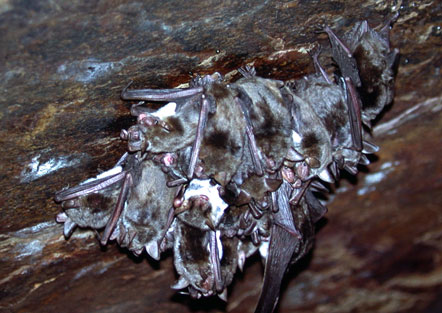Myotis blythii
Lesser Mouse-eared Bat
Morphological description Life history Distribution Habitat Roost sites and roosting patterns Emergence and flight pattern Foraging behaviour Echolocation calls Status and protection
Morphological Description
· Dorsal fur is light brown. Ventral fur is grey or white-grey.
· This is a relatively large myotis. We captured one male (forearm length 60.6mm) and one female (forearm length 62.5mm) from Beijing Range of forearm length 55.5-58.3 mm (Bates & Harrison, 1997).
· Life history
· Mates in autumn, including hibernation period.
· Single young is born in spring.
Distribution
Zhang et al.'s (1997) map covers much of eastern China, including southwestern Sichuan, Yunnan, Guangxi, Fujian, Zhejiang, Shaanxi, Inner Mongolia, Changjiang (M. myotis) and Inner Mongolia, Xinjiang, Shaanxi and Guangxi for M. blythii. The relationships among these taxa merits further study, and the identifications are questionable.
Habitat
· Bates & Harrison (1997) noted that habitats include scrub forest, low foothills.
Roost sites and roosting behaviour
· Roosts in caves, buildings, fissures and trees. This species often share their roosts with other bat species. In a cave in Sihe village, Beijing, the lesser mouse-eared bat roosts with greater horseshoe bats, Rickett's myotis and tube-nosed bats.
Emergence and flight pattern
· M. blythii has relatively broad wings and is probably a manoeuvrable species. It hunts by gleaning (Arlettaz et al. 2001).
Foraging behaviour
· Five droppings analysed from Wanglaopu, 10 July 2002 by GJ seemed to contain exclusively beetle remains. In Europe the diet mainly consists of bush crickets (60%) and varied seasonally in the Swiss Alps. Furthermore, it also eats Tettigoniidae, Lepidopteran larvae, Melolontha (Arlettaz, 1996).
· Foraging behaviour is highly flexible (Arlettaz, 1996).
Echolocation calls
. Myotis blythii emits broadband echolocation calls.
Status and protection
· There is no estimation of population size in China for this species.
· Lesser mouse-eared bats bats are at LR/lc, assessed by the Red List of Threatened Species (IUCN, 2006) and are not listed in the Law of the People's Republic of China on the Protection of Wildlife in 1989.
· Caves and their surroundings should be protected as their habitats.
